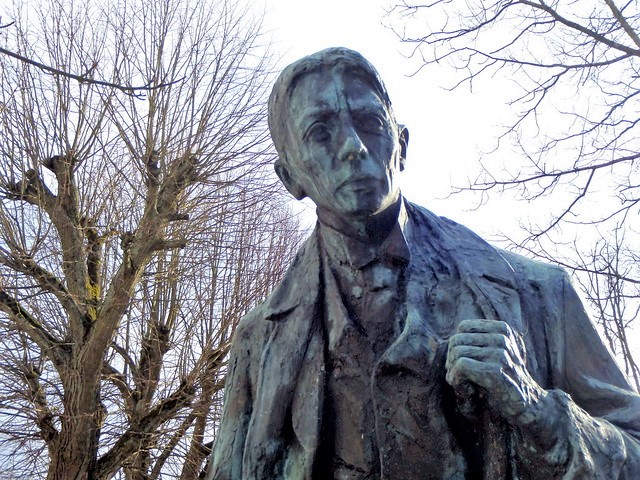Kjeld Abell (1901-1961)
Kjeld Abell is one of the most prominent and innovative Danish playwrights in the 20th century. In his early plays he satirises the narrow, conventional outlook of the bourgeoisie from a socialist viewpoint. Later, he focuses on political commitment and moral dilemmas, inspired by World War II and the German occupation of Denmark, while the post-war dramas become increasingly more symbolic and visionary in their universal treatment of the fundamental themes of love, isolation, community, life and death. Together with Kaj Munk, Abell regenerated Danish drama from the 1930s.

Kjeld Abell was born in Ribe in 1901. After his degree in political science from Copenhagen University in 1927 he spent the following years in Paris and London, studying all aspects of modern theatre and stagecraft. The experience and the skills which he acquired during this period were to have a profound influence on the composition and staging of his future plays.
His first play, Melodien der blev væk (1935) (The Melody That Got Lost, 1939), was a huge success. Here and in his second play, Eva aftjener sin Barnepligt (1936) (Eva does her childhood service), Abell light-heartedly explores the plight of the individual (the ordinary ‘little’ man and woman), faced with stifling bourgeois conventions and daily routines, and his underlying socialist sympathies with the white-collar proletariat are obvious.

In his plays, Abell often admonished the bourgeoisie for its lethargy and hypocrisy. (Public domain)
In Anna Sophie Hedvig (1939) (Eng. tr. 1944) the mood is far more sombre on the eve of the Second World War. In a way reminiscent of an Ibsen play, it is gradually revealed how a seemingly insignificant elderly woman teacher murdered her dictatorial headmistress in order to defend her little world and what she believes in. As this gradually comes to light at an affluent middle-class dinner party, it simultaneously exposes the rank hypocrisy of most of the other characters, while at the end this representative moral conflict in everyday life is juxtaposed with the struggle against tyranny in the Spanish Civil War. The last image shown is that of the protagonist joining a condemned Spanish freedom fighter before an execution squad. The moral of the play is clear: passivity and neutrality are dangerous; one has to be committed and, if necessary, resort to violence in the fight against dictatorship and fascism in all aspects of life.
A similar theme appears in Judith (1940), which had its first performance shortly before the German occupation. The protagonist is here simultaneously the biblical character and a modern society woman, but the central problem of action rather than words is less forcefully presented. Thus it is significant that the person of action (the murderer) is not Judith (whose hands are ‘unworthy’), but the brothel madam, Mrs. Branza, and Holofenes is seen less as a tyrant than as a symbol of national weakness.
During the German occupation of Denmark
In the five years of German occupation of Denmark during the Second World War, when theatres were subjected to strong censorship, Abell completed only one serious play, Dronningen gaar igen (1943) (The Queen on Tour, 1955), an over-complicated crime drama, but instead he threw himself into writing music hall comedy and film scripts. From 1941 to 1949 he also held the prestigious post of Director of the Tivoli Gardens. He took a calculated risk when, in January 1944, he stopped a performance at the Royal Theatre in Copenhagen to inform the audience of the German liquidation of his fellow playwright Kaj Munk, which forced him into hiding for the rest of the war.
During this time he worked with the Danish resistance movement and began writing his next play, Silkeborg (1946), a national occupation drama set in a small town in the middle of Jutland. However, despite the intention to honour the fallen freedom fighters, it is typical of Abell that it first and foremost becomes a family drama focusing on the weaknesses found in a number of the central characters.

Statue of Abell's fellow playwright Kaj Munk, who was a member of the resistance against the German occupation. Munk was killed by the Gestapo on January 4th 1944, and Abell interrupted a performance at the Royal Theatre in Copenhagen to inform the audience of the liquidation. Photo: Insights Unspoken (CC BY-SA 2.0)
The postwar years: disillusionment and innovation
The postwar years, right up to his premature death, turned out to be a period of intense disappointment and disenchantment for Abell. Instead of an emphasis on community and solidarity, he found a world split between two superpower blocks with the constant threat of a nuclear war. The rest of Abell’s major plays reflect his disillusion, but he never manages to come up with a credible solution to it. Rather, he seems to pose the same problem time and again in new, though admittedly imaginative, ways.
And new they certainly were, for Abell’s main contribution to the drama of the late 1940s and the 1950s consists more in his innovative and experimental treatment of the form and staging of his plays; he appeals to the imagination by a suspension of the usual concepts of time and place rather than to action and dramatic plots. Hence, the focus is on the internal struggles of the characters rather than on their deeds and exploits. But this means that Abell’s interest in the foibles and ills of society in general in the early plays shifted to an exploration of the doubt and despair that individuals experience in a time of alienation and despondency. It becomes a problem of life and death – and which is the better choice.
This conflict is played out for the first time in Dage paa en Sky (1947) (Days on a cloud), in which a parachutist has to decide whether to open his parachute or not; in other words, whether life is worth living. The ‘action’ (such as it is) takes place at different spheres across time: the past world of the Greek gods and (not least) goddesses, the present one of the atom bomb, and the protagonist’s own mind. It is an intricate scenario, not easy to follow, but in the end, as generally in the other plays from this period of time, he ultimately chooses life. However, it is not a foregone conclusion in a largely meaningless world.
Devastating judgements of modern individualism
The next two important plays present more or less the same (inner) conflict. Vetsera blomster ikke for enhver (1950) (Vetsera doesn’t bloom for everybody) is loosely modelled on the Mayerling incident when the Austrian Crown Prince Rudolph and his mistress, the 17-year-old Baroness Maria Vetsera, jointly committed suicide. Once again, Abell uses a historical event as the point of departure for his drama, but here the male protagonist (David), the heir of the dilapidated family mansion Mayerling, has actually committed suicide. We learn that he was a vain and inept aesthete, unfit for life, having opted for isolation and ultimately death instead of for Abell’s preferred choice: human interaction and community. The play gradually reveals his weak, self-absorbed personality through his relationships with two women, the young Vetsera and the sister-in-law Alice. This may well be seen as Abell’s most devastating judgement of modern individualism in all its intellectual isolation, inaction and impotence. The answer to Abell’s perennial underlying question of whether life is worth living is nowhere displayed more negatively than in this play.
A few years later a similar conflict is played out in Abell’s arguably greatest play, Den blå pekingeser (1954) (The Blue Pekinese, 2017). However, while the key tenet of the play may be familiar, the staging shows Abell at the height of his powers. The action takes place simultaneously in a mondane café and in a house on the tiny island of Iselø (which means almost ‘isolation island’ in Danish), where the female protagonist Tordis Eck is in the process of committing suicide, but by chance her intention has been conveyed to the male protagonist André, with whom she previously was in love. He desperately tries to ring the local doctor, while Tordis seems to be in a kind of subconscious telepathic contact with André. The time frame is complex as it encompasses three levels: the past (e.g. their love affair and other former happenings on Iselø, but chiefly the bizarre character of the long departed, eccentric Isabella de Creuith and her unruly dog Dicky (a blue pekinese)); the future in the shape of the as yet unborn child Esmond; as well as the present, namely Tordis’s struggle between life and death. It is a theatrical tour de force that makes great demands on the audience. The by now familiar Abell question (whether life is worth living) is played out with an even greater intensity than before and involves dark and demonic forces and possessed characters such as Isabella and her dog, alongside fantastical occurrences like the speeches of the unborn Esmond and his reluctance to enter this world. In the end, however, Tordis comes through her crisis and chooses life over death, love over extinction, but it is a very close call. Abell’s pessimism about his own time is still profound.
Abell’s adaptation of Alexandre Dumas the Younger’s novel La Dame aux Camélias, Kameliadamen (1959) (The Lady of the Camellias) is less successful as a play. The all-conquering force of love is again the main theme, but the scenic realisation of it is unconvincing.
One posthumous play portraying despair
Abell’s last play Skriget (The Scream, 1961), first performed after his death, is in part modelled on the earliest kind of drama. The fantastical world of talking birds is reminiscent of Aristophanes’s comedy The Birds, but this is just one of three planes that the play moves between, the two others being our contemporary world and a biblical world centred on the story of Jephthah’s daughter (Judges 11), who became an unintended human sacrifice. The play deals with various degrees of freedom, with an attack on Old Testament anti-life attitudes, the fear and isolation featured in his previous plays and hence the missed opportunities of a richer existence, based on community and solidarity. Thus it continues the familiar themes from most of Abell’s other postwar plays. The title of the play is sometimes rendered as ‘The Cry’, but it is hardly a coincidence that Abell uses the same word that is commonly associated with Edvard Munch’s famous painting. This perhaps, more than anything else, reveals Abell’s underlying feeling of despair, which is such a pervasive force in his later plays.
Summary
Kjeld Abell wrote other plays, including (as we briefly saw) more light-hearted ones, just as he dappled in other genres, but it is his dramatic works beginning with the left-wing social satires of the 1930s via the plays of political engagement (or the lack of it) and, in his last phase, the symbolic dramas with their existential problems and people living in a divided world dominated by the two new nuclear superpowers that will live on. He may not have resolved his inner conflicts, but there is no doubt that he, together with Kaj Munk, revived Danish drama so thoroughly in the mid 20th century that their works for the Danish stage have not so far been equalled, let alone surpassed. Abell, in particular, was the consummate theatre person in his imaginary visions as well as in his capacity for modernist theatre staging, which in many ways was well ahead of its time.
Further reading:
- Martin Banham, ed., The Cambridge Guide to Theatre (Cambridge University Press, 1992).
- Phyllis Hartnoll, ed., The Oxford Companion to the Theatre (Oxford University Press, 1983).
- John Lingard, 'Kjeld Abell' in Dictionary of Literary Biography, vol. 214: Twentieth-Century Danish Writers (Detroit: Gale Group, 1999:14-21).
- Frederick J. Marker, Kjeld Abell (Gloucester, Mass., 1976).
- S. H. Rossel, ed., A History of Danish Literature (Lincoln & London: University of Nebraska Press, 1992:356-58).